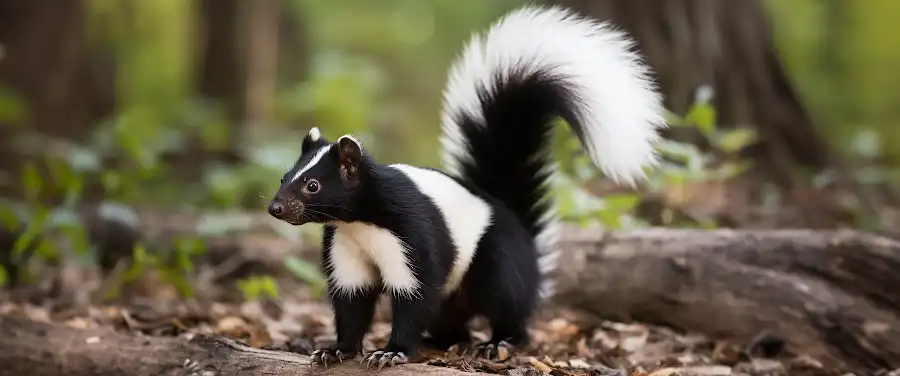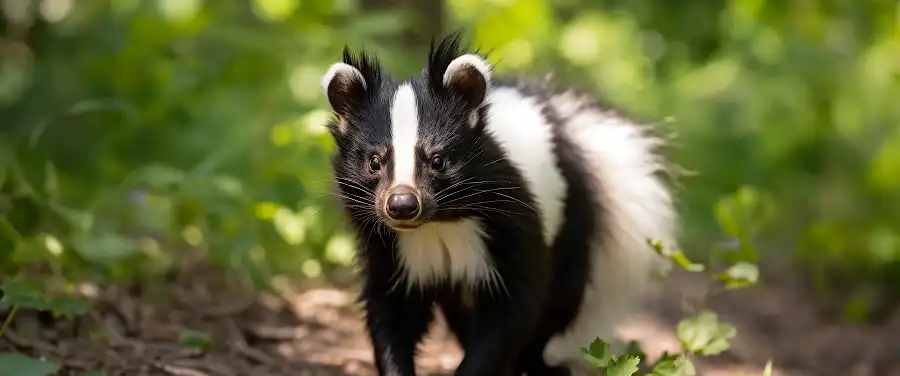
A fine evening in Central Florida can quickly turn foul, thanks to our small, black and white-striped, yet incredibly notorious neighbor – the skunk. The pungent perfume of these mostly harmless creatures, lingers in the air, insinuating an unwelcome existence and is often enough to turn your stomach. Known for their notorious reputation, skunks are far from a pleasant sight, and their issues far outnumber their furry cuteness.
Skunk problems are quite prevalent, a common headache for Central Floridians. Whether it’s the musky and penetrating odor that can be smelled a mile away, the terror of the havoc they wreak in our vegetable gardens, or the fear of pets getting sprayed, the reasons are numerous. Sadly, it’s not always about the aroma, the pest issue goes much deeper. Despite their small size, skunks pose more significant threats you might not initially realize. Their presence should not be taken lightly, as doing so can lead to severe consequences for our health and property.
That’s why addressing these skunk issues is vital. Not to mention the potential for diseases that skunks carry – it’s not just about the stench anymore. Understanding the challenging aspects of their existence, focusing on the risks associated with their presence, helps to foster a balanced cohabitation between us humans and these creatures. Ensuring we are well-versed in dealing with these critters will lead us to the next pressing question: What are some common problems caused by skunks?
Why are Skunks Considered a Nuisance?- Explanation of Nuisance Wildlife
In the grand scheme of Mother Nature’s grand design, every creature has its place and purpose. However, it does not change the fact that sometimes, some creatures can create problems in the human-dominated world. This is what we call nuisance wildlife. Among the lot, skunks often top the list. But why are skunks a nuisance exactly?
Skunks, small to medium-sized animals often recognizable due to their distinct black and white striped body, are unfortunately infamous for their strong, foul odor. Skunks are abundant in North and South America, including Central Florida. With human activity increasing in these regions, interaction between humans and skunks has become common. The skunk characteristics that cause concerns include their residential invasion, the threats they pose to pets, and most notably, their potential to discharge an incredibly foul-smelling spray when threatened.
The mild climate of Central Florida offers an ideal abode for skunks. These nocturnal creatures forage for food at night and often venture into human habitations due to the easy availability of food like garbage and pet feed. They also dig holes in lawns in search of grubs and worms, causing damage to property.
Anyone who owns a pet, especially dogs, knows the threat a skunk poses. A dog’s curiosity could lead to it provoking a skunk, leading to an unpleasant and smelly encounter. Besides the notorious foul odor, skunks can sometimes carry diseases like rabies, which pose a significant health risk to pets and humans alike.
Nevertheless, the most distressing issue associated with skunks is their defense mechanism – a spray from their anal glands that is not just terrible-smelling but can cause temporary blindness and nausea. This infamous attribute earns them their reputation as nuisance wildlife, making the discussion on why skunks are a nuisance an important topic when it comes to wildlife management.
The problems caused by skunk presence are not only a matter of personal inconvenience but also a broader environmental concern. A study by the Journal of Mammalogy states that skunk-related vehicle accidents account for 7% of total wildlife-related vehicle collisions in the United States.
In light of these issues, discussing How Do Skunks Become a Problem? becomes a consequential query to address.
How Do Skunks Become a Problem?

Skunks pose quite an issue to our peaceful residential life in Central Florida. Their unsolicited presence is often prompted by two primary factors: the availability of food and suitable shelters in inhabited regions. A combination of these elements often attracts skunks to residential quarters, thus turning their charming presence into a disturbing ordeal.
Common food sources for skunks
Relatively omnivorous by nature, skunks primarily feed on insects and larvae. However, they are not beyond scavenging trash cans and pet food bowls left outside. These seemingly harmless actions can attract a visit from these curious creatures. Skunks are lover of sweet corn, melons and pet food; hence anything along these lines could draw their attention.
Suitable shelters
Skunks are renowned diggers. Their keenness for enclosed spaces, which they find in the form of burrows and natural hideouts, makes gardens and yards perfect residence for them. Preferred nesting locations include underneath storage buildings and other structures that give them the necessary security and concealment from predators.
Skunk breeding behavior
Incredibly adaptive, skunks have a single breeding season from late winter to early spring. However, their terrific sense of adaptation helps them to multiply rapidly even in the suburban habitats.
Population growth rate
Typically, a skunk gives birth to between four and six kits each spring, which begin their independent lives by fall. This quickly multiplying population can swiftly overrun an area if proper management measures are not enforced promptly.
When the Attraction of skunks to residential areas combines with unchecked Skunk breeding, it quickly escalates the Skunk population growth, effectively turning our homes into their playgrounds
In essence, skunks become problematic due to the availability of food sources and suitable shelters in residential areas. A swift population growth, thanks to their adaptability, only adds to the ongoing issue, leaving the residents in a stinky predicament. Further understanding of their behavior, aids in addressing the skunk problem in a more effective manner.
However, it’s not always our keen observation that discloses their presence; sometimes, it’s their strong pungent spray that does the trick. Let’s switch gears and learn to identify the signs of a skunk problem lurking close to home, a topic we’ll delve into next.
Conclusion
Despite their sweet, cartoon-like appearance, skunks aren’t always the most welcome visitors in Central Florida homes. The problems caused by skunk presence aren’t limited to their notorious smell. As we’ve discussed, these mammals can cause significant damage to your garden, become a source of dangerous diseases, and even threaten the wellbeing of your pets.
Though they may wreak havoc in our lives, it’s crucial to remember that skunks are also a part of our local ecosystem and play their role in keeping it balanced. Therefore, it’s our responsibility to deal with skunk problems in a responsible and ethical manner. To manage and prevent further skunk related issues, homeowners can engage professional pest control services, or in less severe cases, use skunk repellents, install fences and keep their surroundings clean to discourage skunks from invading their property.
You don’t have to live in fear of a skunk invasion. With the right knowledge and resources, you can ensure that your home remains a skunk-free zone while respecting these creatures’ role in our ecosystem.
Just remember that skunks, like any wild animal, are best admired from a distance. Don’t attempt to feed or interact with them – that’s a surefire way to invite more skunk problems. Be proactive in keeping your home and property clean and unattractive to skunks, and you’re one step closer to living harmoniously with all the wildlife Central Florida has to offer.
So, the next time you’re dealing with a skunk problem – don’t panic.
Turn to the advice you’ve learned here. With a calm, responsible approach, it’s entirely possible to steer clear of the inconveniences and potential dangers skunks might bring. More importantly, remember that handling wildlife should be done with utmost respect and consideration for their well being too.
Let’s share the world harmoniously with all animals, skunks included. Because even these smelly critters have a role to play in our vibrant ecosystem!




